 Facebook
Facebook
 X
X
 Instagram
Instagram
 TikTok
TikTok
 Youtube
Youtube
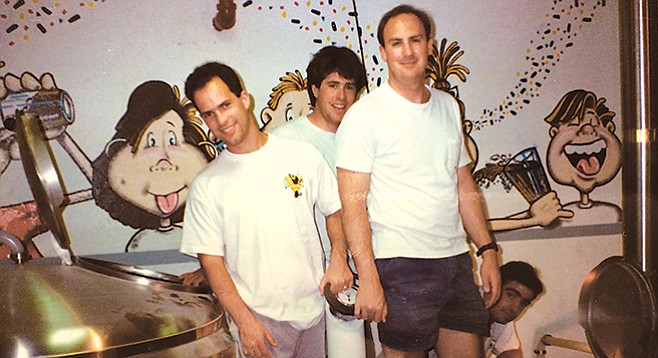
Earlier this month, the San Diego Brewers Guild announced a new study showing that San Diego craft beer made a more than one billion-dollar economic impact in 2017. The news arrives just as Karl Strauss Brewing, San Diego’s oldest craft brewery, is about to celebrate its 30th year in business.
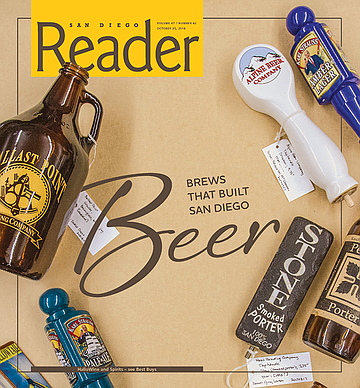
How did one small brewpub downtown grow into a billion-dollar industry populated by more than 150 breweries? I asked that question to more than three dozen brewers, homebrewers, bar owners, and beer enthusiasts who were active within the local beer community from the late 1980s into the 2000s, and found the foundation was built within the first 15 years of San Diego beer.
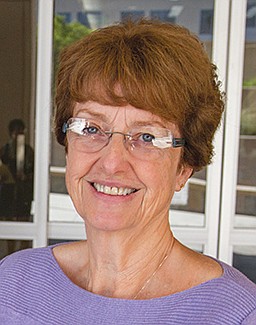
Their first consensus: San Diego used to be a Coors Light town. Here is a look at the beers they say changed that, and established San Diego as one of the top beer cities in the world.
The beginning goes back further than Karl Strauss, to the American homebrew movement that arose after 1978. Forty years ago this month, president Jimmy Carter signed bill HR 1337 into law, amending the U.S. tax code, including a provision effectively legalizing brewing beer at home.
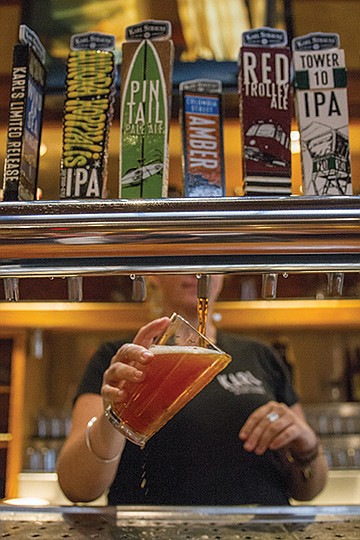
A new generation of homebrewers would need access to equipment and ingredients. According to Judith Downie, the historian preserving San Diego historyat the Brewchives, in the Cal State San Marcos library, a homebrew hobbyist named Audrey Eckblom first provided these in San Diego. She and husband Owen operated an El Cajon shop called Beer and Wine Crafts, where many of San Diego’s first generation of pro brewers got their start. They drove in from miles around to take classes and buy supplies.
One of those brewers was current Karl Strauss brewmaster Paul Segura, who recalls being motivated by an increased federal “sin tax” on retail beer during the first Bush presidency. “We said, screw that, we’ll make our own.”

With Audrey Eckblom’s support, a small group of homebrew hobbyists began gathering in the shop to exchange brewing ideas. In 1989, they formally organized a homebrew club, QUAFF (Quality Ale and Fermentation Fraternity). One of its earliest members, Rich Link, recalls, “A lot of the guys were just interested in making cheap beer.”
However, they departed the club as other members got more serious about producing sound versions of Belgian and English beer styles, which were tough to find at local beer retailers. They began developing a taste for a particular one of beer’s key ingredients. “There were a couple of us that were freaking everyone out with the hops we were using,” says Link.
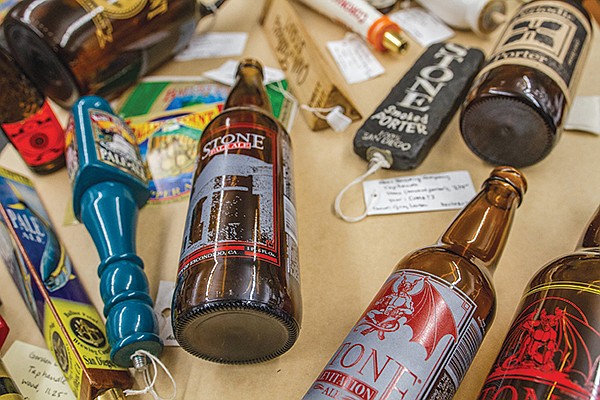
In other parts of the state, homebrewing quickly evolved into what in the early days were called microbreweries. And the early microbrew that made the single largest impact on San Diego beer is unquestionably this hoppy pale ale first brewed in Chico, California in late 1980.
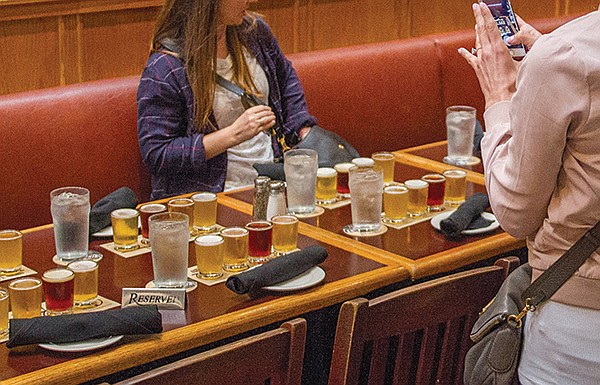
Virtually every brewer active in San Diego during the 1990s cites Sierra Nevada Pale Ale as the beer that first turned them on to hoppy ales. Other California microbrews contributed, including Anchor Steam Liberty Ale, and Humboldt Brewing Co.’s Red Nectar. But for many years, the pine-meets-grapefruit bitterness of Cascade hops in this bottle-conditioned pale made local brewers want more.
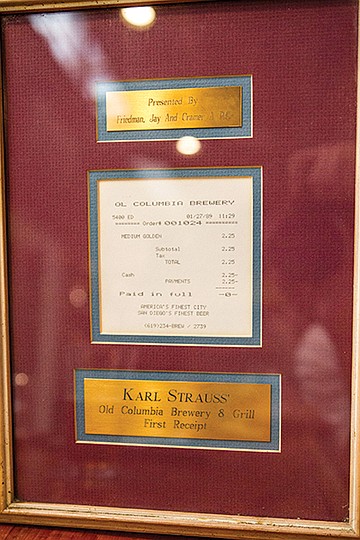
The first microbrew brewed in San Diego County came from Bolt Brewing, a short-lived Fallbrook brewery dreamed up by a trio of La Mesa homebrewers, led by Paul Holborn. Bolt cheaply took over the location of a would-be brewpub called Fergie’s, recalls Clint Stromberg, who served as assistant brewer. Downie’s research suggests Fergie’s never got a license to sell beer, which wasn’t a routine operation in San Diego at the time.
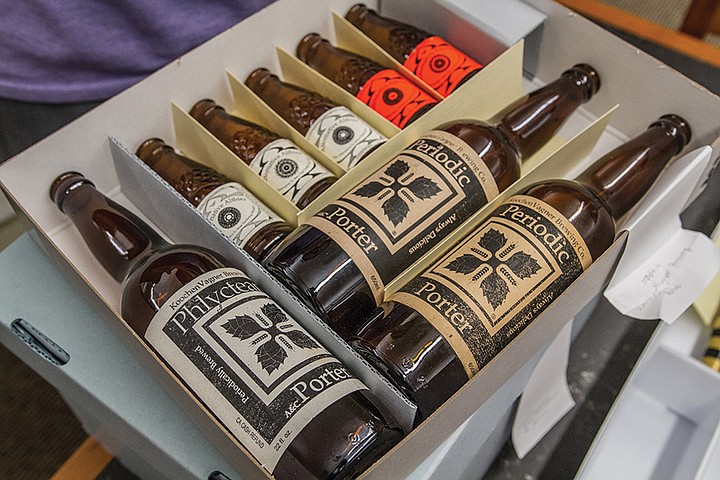
“In those days, the local ABC didn’t know how to handle a brewery license,” recalls Stromberg, “because they had never seen one.”
Small-scale brewing equipment wasn’t readily available either, and Stromberg points to Bolt Pale Ale as the first beer produced on Bolt’s cobbled together one-barrel brewhouse, “the first beer brewed in the county that had a significant number of hops,” he adds. Holborn did not directly contribute this story, but those who knew him around that time describe his brewing style as decidedly hop-forward.
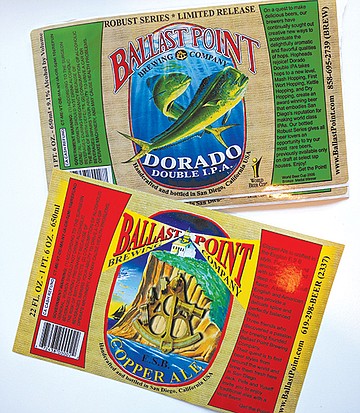
For less than two years, Bolt sold out of its beers every weekend. Unable to meet demand, yet too broke to upgrade brewing capacity, Holborn shut down Bolt in late 1988, when he got an offer to build and operate a larger, well-financed brewery within the old Mission Brewery building. He and Stromberg got to work building what might have been the first microbrewery in the city of San Diego. But a licensing snafu resulted in an ATF raid, and the project never recovered.
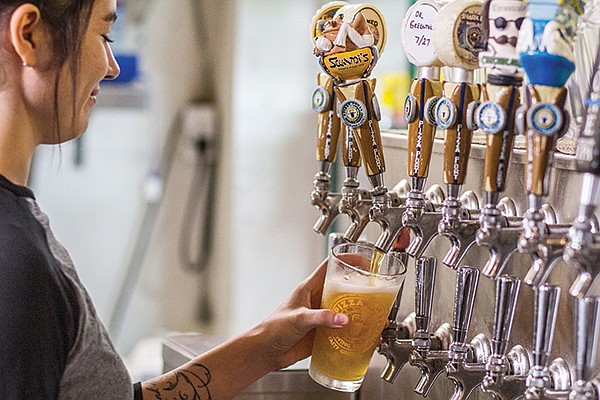
If the two experiences taught Holborn and Stromberg anything, it’s that there was a future in microbreweries, and that those microbreweries would all need small commercial brewing equipment. Both men would next launch careers in brew systems manufacturing.
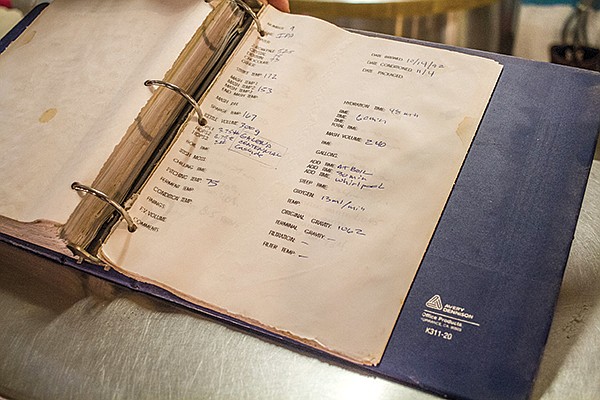
When San Diego’s longest running brewery opened in downtown’s Old Columbia Square in February 2, 1989, the first beer in its lineup was called Old Columbia Amber Lager, and the sign over the door said, “Karl Strauss Old Columbia Brewery and Grill.” To this day, San Diego beer folk who joined early crowds at the city’s first brewery refer to the place as Old Columbia, the most prominent words on that sign.
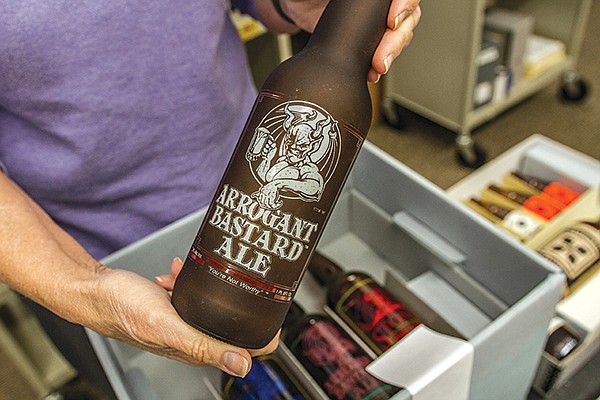
Brewery cofounder Chris Cramer laughs about it now. “We had come up with a name that was too long for people to absorb,” he says. By 1990, the name was shortened to Karl Strauss Brewing, and its flagship beer rebranded as Karl Strauss Amber Lager. Now called Columbia Street Amber, by today’s standards, the malty 4.5-percent, 18-IBU beer is a very lightly bittered brew, but compared to Coors Light, it tasted like a bold departure.
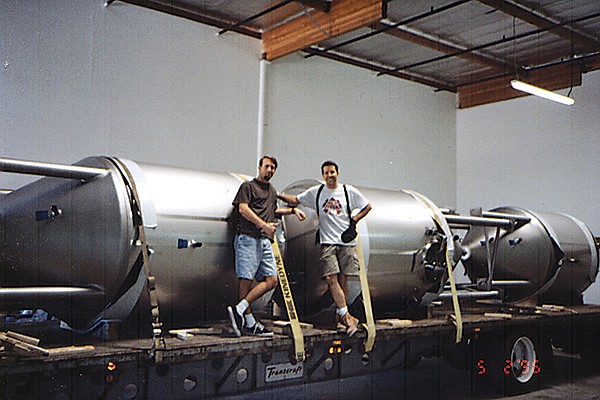
San Diego native Cramer opened Karl Strauss with fellow Stanford alum Matt Rattner. The two MBAs had planned to open a business together, and Cramer figured they had an ace in the hole supporting the brewpub concept: Karl Strauss the man. Cramer’s uncle, and the son of a German brewer, Strauss was concluding a 40-year career with Pabst Brewing Co., and agreed to help the young men embark on what he rightly considered the future of brewing.
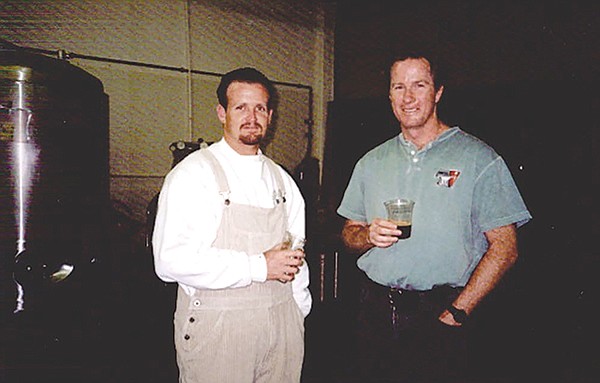
Still growing as a company 30 years on, Karl Strauss would make a huge impact on the future of San Diego beer, and not just for Uncle Karl’s amber lager recipe. Three of the brewpub’s original employees would soon start beer companies of their own.
One of those early Karl Strauss employees was bartender Scott Stamp. When 1989 began, Stamp and his homebrew partner, Lee Doxtader were already determined to open a brewpub of their own, and by 1990 they had opened Callahan’s, taking over an oak-paneled restaurant in a Mira Mesa mall.
Before they could make beer, they had to wait on the only affordable brewing equipment they could find, a three-barrel system built in Mexico, and installed by Paul Holborn. Callahan’s was the first of a wave of brewpubs following Karl Strauss to open brewpubs in the early 90s. Holborn himself opened Red Kettle Brewing in Encinitas, only to close within a year. Through much of the early 90s, these brewpubs lacked access to diverse brewing ingredients, limiting their output to a few standard, generally undistinctive styles.
But Callahan’s had something else in its favor: a license to sell guest beers. Doxtader recalls they didn’t have the cash to set up a full bar, so they made the decision to install 12 taps, at a time when most bars featured only five. “We wanted to give people some variety,” Doxtader says. “The distributors couldn’t understand why we wanted so many taps… they said, ‘You guys are crazy!’”
Consequently, Callahan’s became a go-to destination for local brewers seeking microbrews they couldn’t find elsewhere, and a meeting place for QUAFF homebrewers. Most of Callahan’s beers were made exclusively for the restaurant, but one standout created demand that lasts til this day: Callahan’s Blueberry Wheat. The name would be simplified to Blueberry Wheat after Stamp and Doxtader opened a second brewpub, San Diego Brewing Company, in Grantville (East Mission Valley) in 1993, and began producing the beer there.
Fruit beers gained popularity during this early brewpub era, because beer drinkers still had limits when ordering microbrew, and unlike brewers they weren’t yet ready to embrace the bitterness of hops. In San Diego’s early days, IPAs were occasional, seasonal beers, if they were made at all. “You could not survive in 1989 on hop-forward beers,” recalls Chris Cramer.
But beer drinkers did have a desire for richer flavors. In December of 1989, Uncle Karl offered a recipe for an Irish Red for the brewpub to produce as a holiday seasonal. They called it Cabot, Cabot, and Forbes Christmas Ale, in cheeky reference to the development firm that built the 19-story building across the street from the brewpub. “We’d make it once and never make it again,” says Cramer.
But customers thought otherwise, demanding more of the 17-IBU red ale. So in 1990 the brewpub made it a regular feature, renaming it Red Trolley Ale in a nod to the San Diego trolley stop built beside the brewery that year. As many local brewpubs were about to discover, red ales made an excellent gateway style to introduce people to microbrews. “That was a safe beer to drink back then,” reflects Segura, “It was probably above and beyond what the average consumer was used to, but it wasn’t so foreign, so off the charts… once people got a sip of it, they were okay.”
Among the first wave of brewpubs of the early 90s was Pacific Beach Brewhouse, which opened in 1990 with Clint Stromberg as head brewer, in a Pacific Beach location that houses a Skechers sneaker outlet today. Around 1992, early QUAFF member and president Skip Virgilio took over brewing operations, introducing beers that would inspire brewers throughout San Diego. “Skip’s such a cool dude,” says Lee Chase, who, along with Segura, is one of several first-generation San Diego brewers who introduced formal brewing education to San Diego, courtesy of a master brewing certificate from UC Davis. “He was making some killer beers back when Belgian beer was something only people in the military had ever tried.”
One of these he simply called Belgian Strong Ale. Based on a Belgian tripel, which is loaded with malts and brewed with candi sugar to achieve higher potency. For the latter, Virgilio would have to get creative. “We couldn’t get candi sugar very readily back then,” he remembers, “so I tried to make my own in the kitchen there at the brewhouse.”
Not only would it be the first Belgian beer produced in San Diego, but it became the first San Diego beer to win a gold medal at the Great American Beer Festival, the nation’s most distinguished beer competition. Pacific Beach Brewhouse closed in 1994, but Virgilio went on to revive the beer at his own brewery, AleSmith. However, since the ATF wouldn’t let a San Diego company produce a beer with Belgium in its name, he had to rebrand the award winner Horny Devil.
That thirst for red ale lured microbrew fans into hoppier depths when a Solana Beach pizza parlor brewed its first beer. The So Cal beach culture had lured Gina Marsaglia west to open the pizza joint in 1987. A few years later, her brother Vince followed from their home state of Colorado, where he’d taken an interest in brewing while working on a Coors canning line.
The siblings traded pizza to a nearby Hot Dog on a Stick in return for lemonade containers they could use to homebrew. When Karl Strauss opened, Gina landed a waitress job, giving her a front row seat of brewpub life in action. So when the health department dinged her and Vince for homebrewing in the back of their shop, the Marsaglias decided to invest in brewing equipment and put their own beachy spin on the brewpub model.
Gina recalls watching the responses on customers’ faces when they first experienced the hops in Shark Bite (55 IBU). “It was very aggressive at the time” she says, “people didn’t like it.” Early on, 90 percent of Pizza Port’s house beer income came from its lightest beers. And because all the beers were priced the same — $2.50 a pint — the barleywine outsold the IPA which was sought by drinkers who only wanted it for its high alcohol content.
But Shark Bite and that IPA did have a few big fans in one key demographic: local brewers, many of whom would go on to produce some of San Diego’s best known beers. “That was heavily hopped beer at that time,” says Tomme Arthur, then a local homebrewer, now one of the most acclaimed brewers in the country. “They went well with pizza.”
Swami’s IPA (72 IBU) is like the first Velvet Underground record. Only a few people drank it, but they all went on to brew West Coast IPAs. After Sierra Nevada Pale Ale, this is the beer most credited with launching the pursuit of hoppy brews in San Diego. The first rendition was maltier than the modern version, flavored with oak chips left over from the construction of Pizza Port’s bar, and even served on nitro. But it was definitely pushing the boundaries of how hoppy San Diego beer could get, thanks in part to a familiar face.
When the Marsaglias bought brewing equipment to make Pizza Port a brewpub, it was Paul Holborn who supplied it. By this time Paul was manufacturing brewing equipment with Rob Soltys, who now owns Premier Stainless Systems, the Escondido manufacturer that has built scores of San Diego breweries, plus scores more around the planet.
Holborn and Soltys joined the Marsaglias for the first 9 or 10 Pizza Port brew days, helping dial in the equipment. As they collaborated in scaling up recipes for a commercial system, the resulting beers turns out noticeably hoppier than the Marsaglias’ original homebrew versions. “I thought I was brewing an English IPA,” claims Vince, “Then some people from London came over and tried it.” The British customers told him, “You’re crazy! This is rocket fuel!”
Others remember it differently.
“Swami’s stands out to me so much,” says Vinnie Cilurzo, cofounder of Northern California’s Russian River Brewing Co., best known as the producer of Pliny the Elder, one of the world’s most highly sought IPAs. Cilurzo spent time in San Diego during college, and became one of those early QUAFF members pushing peoples’ hop tolerance with his recipes. “I remember it being this big, hoppy beer, what we now call West Coast IPA.”
Cilurzo was a Temecula native; his parents effectively established the region as wine country when they planted the first commercial vineyard there. So when he left San Diego after his QUAFF days, he brewed in the winery’s basement, started a Temecula homebrew club and, in 1994, cofounded Blind Pig Brewing, a short-lived microbrewery pouring growler fills out of a converted office. That’s where he first made Blind Pig IPA (75 IBU), which now sells well as part of the Russian River roster. “We purposely stayed away from pale ale because Sierra Nevada was already making a pale ale,” he says.
While he credits Sierra Nevada for establishing a hoppy beer market, that was still in its infancy in 1994. “It wasn’t easy to sell beer like that, to sell IPA,” Cilurzo remembers, “It was a struggle in fact. There were very few places willing to sell a beer like that.” The Temecula IPA did find fans in San Diego, thanks to bars that would sell it, including North Park’s Live Wire (opened in 1992) and Kearny Mesa’s O’Brien’s Pub (1994). Those brewers who tasted Blind Pig IPA back then still recall it as the next step in the evolution of the San Diego IPA.
Cilurzo accomplished another brewing milestone at Blind Pig before marrying his wife, Natalie, and moving to Northern California to launch a brewery with Korbel Winery (which the Cilurzos would later buy and rename Russian River). Still getting used to the brewery’s ramshackle brewing system, he overloaded his very first brew with so many hops, he calculated it over 100 IBUs (International bitterness units), effectively inventing the style now called double IPA.
A regular IPA was already a tough sell, so he aged it with oak chips for months to mellow it out, and released it as Inaugural Ale to celebrate Blind Pig’s first anniversary, and wasn’t even sure his regular San Diego customers would buy it (they did). “If you’d have told me then that IPAs would become the most consumed craft beer,” Cilurzo offers, “I would have said no way.”
Nevertheless, Cilurzo made it again for Blind Pig’s second anniversary, and remembers selling the last drop of it as a growler fill for a homebrewer from Los Angeles who’d recently moved to town, and would soon play a big role in making IPAs the most popular craft beer style in the country: Stone Brewing cofounder Greg Koch.
After Pacific Beach Brewhouse closed in 1994, Skip Virgilio partnered up with fellow QUAFF member Ted Newcomb to open a brewery in Miramar. AleSmith bypassed the brewpub model to focus exclusively on beer sales. “We both knew how to make beer,” says Virgilio, “but we didn’t know anything about operating a restaurant, so we just wanted to make beer and not deal with the hassle.”
But the distribution model proved a hard slog. Distributors had no interest, tasting room sales were tightly regulated, and while San Diego bars came around to seeing the value of offering microbrew on draft in the mid 90s, they rarely left room for local beer. “It was a novelty,” remembers brewer Tom Nickel, owner of O’Brien’s Pub since 2003. “So the bars could say, yes we carry a local beer.”
He says typical lineup might include a couple of macro lagers such as Coors Light; popular microbrews such as Sam Adams Boston Lager or Sierra Nevada Pale Ale; and imports Guinness Stout and Newcastle Brown Ale. All San Diego beers would compete for that one slot, and drinkers didn’t place much value on a brand being new and unknown.
However, San Diegans had gotten a taste for brown ales thanks to Newcastle, and AleSmith’s Nautical Nut Brown gained traction as a brown alternative. Brewed with nine different shades of malt, the nuanced brown was far less sweet than Newcastle, giving those who tried it an appreciation for something drier. Brewer Pat Korn remembers drinking it for the first time, and shared the reaction of many, thinking “This tastes better than Newcastle!”
The company survived, but Newcomb soon left, and Virgilio worked long hours to keep beer flowing until 2002, when he sold the company to spend more time at home with his young family. New owner Peter Zien tweaked the recipe and renamed the beer AleSmith Nut Brown, which became a ubiquitous presence at local bottle shops once craft beer hit the mainstream. “We were trying to craft a beer that had some good color,” says Zien, “good cocoa derived flavors, without any chocolate in the beer.”
With the help of Nut Brown, AleSmith became profitable in 2008, the same year it was named small brewery of the year at the Great American Beer Festival.
Greg Koch and Steve Wagner first met as musicians in Los Angeles, then bumped into each other again taking a weekend beer appreciation course at UC Davis. Their shared interests led to homebrew sessions, and they even bottled a few of their beers as Koochen Vagner Brewing Co.
When they decided to open Stone Brewing, they decided to go big, at least in microbrew terms. Whereas AleSmith had opened with a 15-barrel brewhouse, Stone opened with a 30-barrel system. And while these days, Stone breweries double as large restaurants, back then Koch and Wagner decided to nix food service.
“Neither of us had any significant restaurant experience, and we were really getting into this because of our love of beer,” says Wagner, “Starting a brewery and restaurant seemed like starting two businesses at once!”
It worked. Eventually. Stone introduced its eponymous Pale Ale first, and in 1997 in would become the first San Diego-produced beer distributed in bottles. Measuring 42 IBUs, Stone Pale was only slightly more bitter than Sierra Nevada Pale Ale, but when Koch and Stone’s then-vice president of sales, Arlan Arnsten, brought samples to beer buyers in San Diego, the majority turned them down. “People were asking us why we didn’t make a raspberry hefeweizen,” recalls Arnsten. But Stone had no intention of stopping at 42 IBUs.
A Karl Strauss brewery tour guide in 1989, by 1996, Jack White had opened two locations of Home Brew Mart, a homebrew supply shop started in Linda Vista to increase homebrewers’ access to a wider palate of ingredients. Scores of Home Brew Mart’s early customers make beer today in one of more than 150 breweries populating the county.
White enlisted his first employee, Yuseff Cherney, and his college roommate, Pete A’Hearn, another UC Davis master brewer, to help start Ballast Point in 1996. They didn’t have a beer license squared away when they brewed the first Ballast Point beer, so Vince Marsaglia hosted them at Pizza Port Solana Beach.
They brewed “The Special,” described at the time as a copper ale, aggressively hopped and nitrogenated. Despite high hopes, The Special wasn’t a hit, but Ballast Point wouldn’t give up on it. They rebranded it Calico Copper Ale, then Calico ESB, and when nobody knew what an ESB was, they called it Calico Amber Ale — ambers were considered safe microbrews to order at the time. Eventually, it would be dubbed California Amber Ale, as the most award-winning beer in what is now a very large beer portfolio.
Also present at that first brew was a homebrew pal of Cherney’s, a biochemistry grad student at UCSD named Chris White. While pursuing a PhD, White supplemented his interest in homebrewing by collecting yeast strains, which he propagated for the Ballast Point beer. “I spent a couple of weeks getting yeast ready,” White recalls, “it was a really big deal, a lot of fun.”
There are more than 1500 species of yeast, but in the 1990s, brewers, and especially homebrewers, didn’t have any choices of yeast available. They relied on dry yeast, meaning they had to plan ahead before a brew day, and propagate yeast at least a day in advance. At his friends’ urging, White began propagating his most versatile yeast specimen and selling it through Home Brew Mart in liquid vials, ready to pitch into a homebrew vessel immediately after purchase. Initially, the busy grad student thought of it as a side venture, but then he realized the demand.
“At one point I was just doing this one strain, 40-50 per week,” White recalls, “I would bring them to Home Brew Mart on a Thursday, and they would be gone by Saturday.” His yeast also showed commercial potential. Early on, White traded yeast to Pizza Port in return for pizza. He would name the strain California Ale Yeast, and give it the number 001 of his new business, White Labs. Today, the business operates internationally, with multiple labs furnishing 68 yeast strains to countless homebrewers and thousands of breweries, while maintaining proprietary strains for dozens more.
“That became a business that fed the craft beer scene,” says Cherney, “and gave it world class yeast that was consistent.” And San Diego brewers have had access to this crucial brewing ingredient since the mid-90s.
Its Pale Ale still barely had a foothold when Stone celebrated its first anniversary, but that didn’t stop Koch and Wagner from releasing an IPA with such a pronounced bitterness (71 IBU) for that era, that their contemporaries described drinking it for the first time as like “a punch in the mouth” or “a smack in the face.”
Stone IPA made a huge impact on a growing legion of hopheads. Like spicy food, once someone has developed a taste for hops, they want more. Although everyone I spoke to for this story remembers drinking Stone IPA for the first time as a turning point in the San Diego beer industry, it only gained a cult following at first. For several years Stone Pale remained the brand’s gateway beer, accounting for 80 percent of its sales.
A less hoppy beer was paying the bills over at Ballast Point. Its Yellowtail Pale Ale (30 IBU) was based on a Kolsch, the crisp German take on a blond ale, and a few years back its name was changed to California Kolsch. “It was a little hoppier, and a little different from a traditional German beer,” explains Cherney, “but it wasn’t anything like the IPAs.”
But San Diegans loved it, and considered themselves pale ale fans, showing up in droves to buy converted soda kegs of it, thereby establishing the beer as a staple of local house parties. Curiosity about ales was on the rise, and the brewery manned by a small crew in the back of a home brew shop had gained a following. “That beer was our breakthrough to the market,” Cherney notes. But, he adds, “it was a nightmare to clean those kegs.”
Stone didn’t just name a beer Arrogant Bastard; it printed a challenging declaration on the front of the bottle: “You’re not worthy.” Provocation continued on the back: “This is an aggressive beer. You probably won’t like it. It’s quite doubtful that you have the taste or sophistication to be able to appreciate an ale of this quality and depth.”
People took the bait. Not just brewers and beer geeks, but those shopping for mild ales and lagers. “That was kind of a big F.U. to a lot of different people,” says Paul Segura. “As a man, who wouldn’t take that up as a challenge?” Stone’s Gargoyle logo made a good troll.
For all the bluster, the Bastard was an accident. Steve Wagner explains he miscalculated the hop additions while scaling the recipe of a different beer, and wound up brewing a potent, malty ale with a hugely overblown hop profile. Wagner intended to dump it, but says his partner saw its potential. Koch had already come up with the idea for the name; he’d just been waiting for the right beer to come along and deserve it.
Arrogant Bastard was not sold as an IPA. It was offered as a strong ale, woody in color with a big malt backbone to go with a whole lot of hop bitterness. Whether they wanted to hate it or love it, people with adventurous palates had to try it.
Meanwhile, local brewers were learning to work together. Koch helped establish the San Diego Brewers Guild the same year. Stone’s marketing didn’t just make beer drinkers curious about Stone beers. It made them wonder what the other microbreweries might be doing.
Brewing beers with higher alcohol content or extra hops meant spending more on ingredients, which the economics of local beer did not yet support. “There wasn’t a lot of experimentation, says Tomme Arthur, “A lot that kicked in was relative to the Strong Ale events.”
Arthur and Tom Nickel were brewing at Pizza Port Solana Beach in late 1997 when they had the idea to gather brewers together to share their potent winter seasonal beers over the course of a weekend festival. Pizza Port had just added a second location in Carlsbad, where it hosted the first Strong Ale Festival that December. “It allowed people to showcase their seasonal beers,” explains Nickel, but there was a catch: they had to be higher than eight percent alcohol.
Gina Marsaglia recalls the first year was a small event, but everybody had fun so they kept it going for, well, 22 years so far. Ballast Point brewer Colby Chandler went to the first one, and felt there should be more hoppy beers among the bevy of old ales and imperial stouts. So he brewed a batch of what would eventually be called Crystal Pier Double IPA, due to its use of a new varietal, Crystal hops.
Make that, its quite heavy use of Crystal hops. Brewers had been dry hopping IPAs — that is, adding them after fermentation to acquire aromatic qualities — with a fraction of a pound of hops per barrel. Chandler raised that ratio to three pounds, dry hopping for days to create extreme levels of bitterness. Inspired by Belgian tripel ale, he started with the strongest run of Yellowtail Pale Ale wort, added candi sugar, and fermented it at low temperatures to raise the alcohol over eight percent.
Nobody called it a double IPA that weekend, but it was gone halfway through the first night. The next year, Chandler made twice the amount, and it was gone just as fast. The same thing happened when O’Brien’s founder Jim O’Brien requested a keg for his customers.
By the time Ballast Point officially made it a regular release called Dorado Double IPA, San Diego would offer of a very hoppy landscape.
Pat McIlHenney was a firefighter and QUAFF homebrewer, who started driving from his home in Alpine to volunteer with Skip Virgilio in the early days of AleSmith. Eventually, he asked Virgilio about contract brewing a few recipes.
For one of the first brews of Alpine Beer Co., McIlHenney experimented with hopping techniques, seeking to better express the floral aromatics of hops. “That was my goal,” he says, “to figure out how to retain all the highly volatile aromatic oils and keep them in the beer.”
Along with the Crystal hops of Dorado, a number of newly developed hop varietals were expanding the flavors available to brewers, and for Pure Hoppiness, he was using one called Columbus. He tried several iterations, mainly wanting to impress the palate of his wife Val who gamely responded with the question, “Can you make it more hoppy?”
His final, Val-approved recipe would be an eight percent, 61-IBU double IPA. Virgilio saw his friend pushing the envelope on with expensive hops. “I thought what he was doing was economic suicide, but it was really great beer.”
And it proved good for business. When McIlhenney installed a small brewery in Alpine in 2002, any IPA he produced would sell out in a weekend.
“It was bone dry,” recalls Tomme Arthur. Alpine was served in the occasional favorite pub, but the only reliable way to get it was to drive 30 miles east and up 1800 feet in elevation to get it from the source. And a generation of burgeoning IPA fans did so in droves. “Not much Pure Hoppiness came down the hill.”
Down at sea level, Arthur was pursuing a different direction in Solana Beach: barrel-aged Belgian sours. He’d been working with Belgian yeasts, making a saison, a dubbel, and a tripel. It seemed audacious to serve a quadrupel, but he went ahead and made a 10 percent beer with raisins and candi sugar called the Mother of all Beers, later renamed Judgment Day when he cofounded The Lost Abbey with the Marsaglias in 2006.
He put the large beer into used bourbon barrels with sour cherries and the wild yeast, brettanomyces, and let it evolve.
“Cuvee du Tomme is very important,” says Bill Sysak, “because it was one of the first sours made in America.” It would go on to win Great American Beer Festival medals four out of five years from 2000-2004, in a category once deemed too sophisticated for American craft brewers.
And it ushered in an era of San Diego beer awards dominance.
Entering the 2000s, the term craft beer caught on, and Stone Brewing was one of the brands at the forefront of a growing national trend. The late 90s had been rough on the microbrew industry, but the future of craft beer, and IPAs in particular, looked bright. Stone had launched its own distribution arm in the late 90s, and went about expanding San Diego beer’s reach into other parts of the state with the turn of the milennium.
After debuting Stone IPA for its first anniversary, Stone celebrated its second by doubling the hops. For its third it tripled them, and by its fourth it produced a double IPA at over 100 IBU. After making the fifth anniversary brew, says Steve Wagner, there physically wasn’t room to add any more hops to the tank.
The beer had such a massive hop profile, you couldn’t properly taste anything else afterward. Hence the name, Ruination. Stone had started the escalation of hoppy IPAs in San Diego, and seemed determined to finish it.
All this while, the internet was changing how people learned about and discussed craft beers. When Skip Virgilio first made Speedway Stout, there was little fanfare. It started out as a contract brew for a guy named Charlie who walked into the brewery with a coffee stout recipe written on a scrap of paper. He was convinced he could make money with it, but quickly realized how difficult beer sales were, and gave up, allowing AleSmith keep the beer and its name.
Virgilio developed the recipe, and when he sold AleSmith to Peter Zien, he left it behind with a big fanbase, and bourbon barrels aging the beer. Zien blended and released the first version of Bourbon Barrel Aged Speedway Stout in 2003, only vaguely aware of a user-driven beer rating site called RateBeer.com. Many European beer fans were active on the site, as well as American, so its list of top rated beers tended to be European brews.
But that barrel-aged Speedway shot to the top of the list, where it remained a couple years, making it a must-try beer for a global network of beer geeks, and raising AleSmith’s profile well outside San Diego’s borders.
Rough times in the late 90s largely prevented a lot of breweries from opening in the early 2000s. Green Flash had established itself in Vista in 2002, but struggled for a couple of years with mild tasting beers before hiring journeyman San Diego brewer Chuck Silva, another UC Davis grad. Owner Mike Hinkley asked Silva to brew a beer that he could name West Coast IPA.
Silva told Hinkley that it would have to be a strong one, and he delivered. The beer, at 95 IBU, would be emblematic of what had become known as the West Coast IPA style: heavily dry hopped for aromatics, and dry.
San Diego IPAs had been moving this direction since the introduction of Swami’s. The English IPA recipes they started out with used a lot of crystal malts, which yielded a lot of flavor, diminishing the perception of the hops. As San Diego brewers increased hops, they reduced the amount of crystal malts, so the hops would show up more. As the style evolved, they kept whittling down malts, and increasing hops, steering to a logical conclusion.
Alpine residents Pat and Val McIlhenney needed a getaway following the destructive Cedar Fire of 2003, so they took an anniversary trip to New Zealand, where it was still spring. While visiting a local brewpub, McIlhenney detected a unique hop in one of his beers. It was faint, but distinctive. Nelson Sauvin was so-named for the fact it was grown in the town of Nelson, and yielded aromatics similar to Sauvignon Blanc grapes. The only brewery using the hops in the U.S. was Coors, which blended it with other varietals to lightly hop its lagers.
McIlhenney wanted to see it in a San Diego IPA, so he developed a relationship with a New Zealand hop grower, and secured some, along with another Southern Hemisphere hop, Southern Cross. He used them in a rye IPA recipe he had been developing, and the resulting Nelson IPA (80 IBU) would introduce a whole new range of hop flavors to a craft brew world growing eager for the next new thing.
San Diego now had a cult brewery crafting beer using a new hop from another hemisphere. And you had to go up the hill to get it. Word spread online, and beer enthusiasts from around the country flew in to San Diego so they could drive up to Alpine to get some.
On the heels of Pizza Port’s Strong Ale Fest, some of its brewers started making a habit of attending festivals in other cities and states. Arthur and Nickel took to traveling the country to pour beers and spread the word about San Diego’s rising beer quality. Nickel was working for Oggi’s Pizza & Brewing, which had opened in the mid-90s. Another Oggi’s brewer Jeff Bagby, would join them on the festival circuit. They brought great beer with them, and they brought a party. Before long, they found their audience.
And they started winning competitions. Frequently. They won so many awards, it’s impossible to highlight a single beer that changed public perception of San Diego brews, though there are certainly candidates: Pizza Port brewer Kirk McHale’s Wipeout IPA and Frank Double IPA; or Hop 15 Double IPA, which Arthur and Bagby made together using 15 hop varieties in a single beer. In effect, as demand for IPAs finally kicked in, San Diego brewers had reached the point they could brew for creativity and flavor, without as many production constraints, using the best available ingredients, while challenging one another to refine techniques to make better craft beer, rather than merely escalating hops.
At the 2003 and 2004 editions of the Great American Beer Festival, Pizza Port won a combined 13 medals, while Tomme Arthur and the Solana Beach Pizza Port was named small brewpub of the year, both years.
In between these back-to back wins, the biannual World Beer Cup, the so-called Olympics of beer, was hosted in San Diego for the first time. In his column writing about San Diego beer for industry magazine The Celebrator, Rich Link wrote that, for that week, “San Diego was the center of the brewing universe.”
A revitalized San Diego Brewers Guild embraced the opportunity, and brewers assembled for nighttime gatherings at the Town & Country Hotel, where attendees from around the world sampled from 100 San Diego brewed beers served on draft. Meanwhile, several San Diego breweries won medals in the contest, and Oggi’s was named the top Small Brewing Company in the world, bringing a celebratory buzz to the entire community.
When I ask people what year the world started to celebrate San Diego as a major craft brewing city, they more often than not point to 2004. But they’re not sure the people of San Diego realized it.
But after Ballast Point introduced its 70-IBU Sculpin IPA in 2006, San Diego was firmly established as one of the top beer cities in the nation, and San Diegans knew it. Gastropubs and craft beer bars began to proliferate in neighborhoods around the county, bottle shops cropped up, and brewery tasting rooms, allowed to pour pints and flights, became weekend destinations. Craft beer became a point of civic pride, celebrated even by politicians.
Sculpin came about when QUAFF members and Home Brew Mart employees, Doug Duffield, and George Cataulin separately won awards at the National Homebrew Competition with similarly constructed IPAs. Colby Chandler wanted to give them a chance to brew on the commercial system, so the three brewers combined the two recipes and brewed a six-barrel batch, intending it to be a one-time thing.
But it featured hops that didn’t appear in many commercial brews yet, Simcoe and Amarillo. Though characteristically dry, this West Coast IPA tasty fruity and tropical, the hop oils giving it a juicy character that would become one of the most valued characteristics in IPAdom. The beer became a massive success, often credited as the beer that raised the value of a San Diego craft beer brand to a billion dollars.


Earlier this month, the San Diego Brewers Guild announced a new study showing that San Diego craft beer made a more than one billion-dollar economic impact in 2017. The news arrives just as Karl Strauss Brewing, San Diego’s oldest craft brewery, is about to celebrate its 30th year in business.

How did one small brewpub downtown grow into a billion-dollar industry populated by more than 150 breweries? I asked that question to more than three dozen brewers, homebrewers, bar owners, and beer enthusiasts who were active within the local beer community from the late 1980s into the 2000s, and found the foundation was built within the first 15 years of San Diego beer.

Their first consensus: San Diego used to be a Coors Light town. Here is a look at the beers they say changed that, and established San Diego as one of the top beer cities in the world.
The beginning goes back further than Karl Strauss, to the American homebrew movement that arose after 1978. Forty years ago this month, president Jimmy Carter signed bill HR 1337 into law, amending the U.S. tax code, including a provision effectively legalizing brewing beer at home.

A new generation of homebrewers would need access to equipment and ingredients. According to Judith Downie, the historian preserving San Diego historyat the Brewchives, in the Cal State San Marcos library, a homebrew hobbyist named Audrey Eckblom first provided these in San Diego. She and husband Owen operated an El Cajon shop called Beer and Wine Crafts, where many of San Diego’s first generation of pro brewers got their start. They drove in from miles around to take classes and buy supplies.
One of those brewers was current Karl Strauss brewmaster Paul Segura, who recalls being motivated by an increased federal “sin tax” on retail beer during the first Bush presidency. “We said, screw that, we’ll make our own.”

With Audrey Eckblom’s support, a small group of homebrew hobbyists began gathering in the shop to exchange brewing ideas. In 1989, they formally organized a homebrew club, QUAFF (Quality Ale and Fermentation Fraternity). One of its earliest members, Rich Link, recalls, “A lot of the guys were just interested in making cheap beer.”
However, they departed the club as other members got more serious about producing sound versions of Belgian and English beer styles, which were tough to find at local beer retailers. They began developing a taste for a particular one of beer’s key ingredients. “There were a couple of us that were freaking everyone out with the hops we were using,” says Link.

In other parts of the state, homebrewing quickly evolved into what in the early days were called microbreweries. And the early microbrew that made the single largest impact on San Diego beer is unquestionably this hoppy pale ale first brewed in Chico, California in late 1980.

Virtually every brewer active in San Diego during the 1990s cites Sierra Nevada Pale Ale as the beer that first turned them on to hoppy ales. Other California microbrews contributed, including Anchor Steam Liberty Ale, and Humboldt Brewing Co.’s Red Nectar. But for many years, the pine-meets-grapefruit bitterness of Cascade hops in this bottle-conditioned pale made local brewers want more.

The first microbrew brewed in San Diego County came from Bolt Brewing, a short-lived Fallbrook brewery dreamed up by a trio of La Mesa homebrewers, led by Paul Holborn. Bolt cheaply took over the location of a would-be brewpub called Fergie’s, recalls Clint Stromberg, who served as assistant brewer. Downie’s research suggests Fergie’s never got a license to sell beer, which wasn’t a routine operation in San Diego at the time.

“In those days, the local ABC didn’t know how to handle a brewery license,” recalls Stromberg, “because they had never seen one.”
Small-scale brewing equipment wasn’t readily available either, and Stromberg points to Bolt Pale Ale as the first beer produced on Bolt’s cobbled together one-barrel brewhouse, “the first beer brewed in the county that had a significant number of hops,” he adds. Holborn did not directly contribute this story, but those who knew him around that time describe his brewing style as decidedly hop-forward.

For less than two years, Bolt sold out of its beers every weekend. Unable to meet demand, yet too broke to upgrade brewing capacity, Holborn shut down Bolt in late 1988, when he got an offer to build and operate a larger, well-financed brewery within the old Mission Brewery building. He and Stromberg got to work building what might have been the first microbrewery in the city of San Diego. But a licensing snafu resulted in an ATF raid, and the project never recovered.

If the two experiences taught Holborn and Stromberg anything, it’s that there was a future in microbreweries, and that those microbreweries would all need small commercial brewing equipment. Both men would next launch careers in brew systems manufacturing.

When San Diego’s longest running brewery opened in downtown’s Old Columbia Square in February 2, 1989, the first beer in its lineup was called Old Columbia Amber Lager, and the sign over the door said, “Karl Strauss Old Columbia Brewery and Grill.” To this day, San Diego beer folk who joined early crowds at the city’s first brewery refer to the place as Old Columbia, the most prominent words on that sign.

Brewery cofounder Chris Cramer laughs about it now. “We had come up with a name that was too long for people to absorb,” he says. By 1990, the name was shortened to Karl Strauss Brewing, and its flagship beer rebranded as Karl Strauss Amber Lager. Now called Columbia Street Amber, by today’s standards, the malty 4.5-percent, 18-IBU beer is a very lightly bittered brew, but compared to Coors Light, it tasted like a bold departure.

San Diego native Cramer opened Karl Strauss with fellow Stanford alum Matt Rattner. The two MBAs had planned to open a business together, and Cramer figured they had an ace in the hole supporting the brewpub concept: Karl Strauss the man. Cramer’s uncle, and the son of a German brewer, Strauss was concluding a 40-year career with Pabst Brewing Co., and agreed to help the young men embark on what he rightly considered the future of brewing.

Still growing as a company 30 years on, Karl Strauss would make a huge impact on the future of San Diego beer, and not just for Uncle Karl’s amber lager recipe. Three of the brewpub’s original employees would soon start beer companies of their own.
One of those early Karl Strauss employees was bartender Scott Stamp. When 1989 began, Stamp and his homebrew partner, Lee Doxtader were already determined to open a brewpub of their own, and by 1990 they had opened Callahan’s, taking over an oak-paneled restaurant in a Mira Mesa mall.
Before they could make beer, they had to wait on the only affordable brewing equipment they could find, a three-barrel system built in Mexico, and installed by Paul Holborn. Callahan’s was the first of a wave of brewpubs following Karl Strauss to open brewpubs in the early 90s. Holborn himself opened Red Kettle Brewing in Encinitas, only to close within a year. Through much of the early 90s, these brewpubs lacked access to diverse brewing ingredients, limiting their output to a few standard, generally undistinctive styles.
But Callahan’s had something else in its favor: a license to sell guest beers. Doxtader recalls they didn’t have the cash to set up a full bar, so they made the decision to install 12 taps, at a time when most bars featured only five. “We wanted to give people some variety,” Doxtader says. “The distributors couldn’t understand why we wanted so many taps… they said, ‘You guys are crazy!’”
Consequently, Callahan’s became a go-to destination for local brewers seeking microbrews they couldn’t find elsewhere, and a meeting place for QUAFF homebrewers. Most of Callahan’s beers were made exclusively for the restaurant, but one standout created demand that lasts til this day: Callahan’s Blueberry Wheat. The name would be simplified to Blueberry Wheat after Stamp and Doxtader opened a second brewpub, San Diego Brewing Company, in Grantville (East Mission Valley) in 1993, and began producing the beer there.
Fruit beers gained popularity during this early brewpub era, because beer drinkers still had limits when ordering microbrew, and unlike brewers they weren’t yet ready to embrace the bitterness of hops. In San Diego’s early days, IPAs were occasional, seasonal beers, if they were made at all. “You could not survive in 1989 on hop-forward beers,” recalls Chris Cramer.
But beer drinkers did have a desire for richer flavors. In December of 1989, Uncle Karl offered a recipe for an Irish Red for the brewpub to produce as a holiday seasonal. They called it Cabot, Cabot, and Forbes Christmas Ale, in cheeky reference to the development firm that built the 19-story building across the street from the brewpub. “We’d make it once and never make it again,” says Cramer.
But customers thought otherwise, demanding more of the 17-IBU red ale. So in 1990 the brewpub made it a regular feature, renaming it Red Trolley Ale in a nod to the San Diego trolley stop built beside the brewery that year. As many local brewpubs were about to discover, red ales made an excellent gateway style to introduce people to microbrews. “That was a safe beer to drink back then,” reflects Segura, “It was probably above and beyond what the average consumer was used to, but it wasn’t so foreign, so off the charts… once people got a sip of it, they were okay.”
Among the first wave of brewpubs of the early 90s was Pacific Beach Brewhouse, which opened in 1990 with Clint Stromberg as head brewer, in a Pacific Beach location that houses a Skechers sneaker outlet today. Around 1992, early QUAFF member and president Skip Virgilio took over brewing operations, introducing beers that would inspire brewers throughout San Diego. “Skip’s such a cool dude,” says Lee Chase, who, along with Segura, is one of several first-generation San Diego brewers who introduced formal brewing education to San Diego, courtesy of a master brewing certificate from UC Davis. “He was making some killer beers back when Belgian beer was something only people in the military had ever tried.”
One of these he simply called Belgian Strong Ale. Based on a Belgian tripel, which is loaded with malts and brewed with candi sugar to achieve higher potency. For the latter, Virgilio would have to get creative. “We couldn’t get candi sugar very readily back then,” he remembers, “so I tried to make my own in the kitchen there at the brewhouse.”
Not only would it be the first Belgian beer produced in San Diego, but it became the first San Diego beer to win a gold medal at the Great American Beer Festival, the nation’s most distinguished beer competition. Pacific Beach Brewhouse closed in 1994, but Virgilio went on to revive the beer at his own brewery, AleSmith. However, since the ATF wouldn’t let a San Diego company produce a beer with Belgium in its name, he had to rebrand the award winner Horny Devil.
That thirst for red ale lured microbrew fans into hoppier depths when a Solana Beach pizza parlor brewed its first beer. The So Cal beach culture had lured Gina Marsaglia west to open the pizza joint in 1987. A few years later, her brother Vince followed from their home state of Colorado, where he’d taken an interest in brewing while working on a Coors canning line.
The siblings traded pizza to a nearby Hot Dog on a Stick in return for lemonade containers they could use to homebrew. When Karl Strauss opened, Gina landed a waitress job, giving her a front row seat of brewpub life in action. So when the health department dinged her and Vince for homebrewing in the back of their shop, the Marsaglias decided to invest in brewing equipment and put their own beachy spin on the brewpub model.
Gina recalls watching the responses on customers’ faces when they first experienced the hops in Shark Bite (55 IBU). “It was very aggressive at the time” she says, “people didn’t like it.” Early on, 90 percent of Pizza Port’s house beer income came from its lightest beers. And because all the beers were priced the same — $2.50 a pint — the barleywine outsold the IPA which was sought by drinkers who only wanted it for its high alcohol content.
But Shark Bite and that IPA did have a few big fans in one key demographic: local brewers, many of whom would go on to produce some of San Diego’s best known beers. “That was heavily hopped beer at that time,” says Tomme Arthur, then a local homebrewer, now one of the most acclaimed brewers in the country. “They went well with pizza.”
Swami’s IPA (72 IBU) is like the first Velvet Underground record. Only a few people drank it, but they all went on to brew West Coast IPAs. After Sierra Nevada Pale Ale, this is the beer most credited with launching the pursuit of hoppy brews in San Diego. The first rendition was maltier than the modern version, flavored with oak chips left over from the construction of Pizza Port’s bar, and even served on nitro. But it was definitely pushing the boundaries of how hoppy San Diego beer could get, thanks in part to a familiar face.
When the Marsaglias bought brewing equipment to make Pizza Port a brewpub, it was Paul Holborn who supplied it. By this time Paul was manufacturing brewing equipment with Rob Soltys, who now owns Premier Stainless Systems, the Escondido manufacturer that has built scores of San Diego breweries, plus scores more around the planet.
Holborn and Soltys joined the Marsaglias for the first 9 or 10 Pizza Port brew days, helping dial in the equipment. As they collaborated in scaling up recipes for a commercial system, the resulting beers turns out noticeably hoppier than the Marsaglias’ original homebrew versions. “I thought I was brewing an English IPA,” claims Vince, “Then some people from London came over and tried it.” The British customers told him, “You’re crazy! This is rocket fuel!”
Others remember it differently.
“Swami’s stands out to me so much,” says Vinnie Cilurzo, cofounder of Northern California’s Russian River Brewing Co., best known as the producer of Pliny the Elder, one of the world’s most highly sought IPAs. Cilurzo spent time in San Diego during college, and became one of those early QUAFF members pushing peoples’ hop tolerance with his recipes. “I remember it being this big, hoppy beer, what we now call West Coast IPA.”
Cilurzo was a Temecula native; his parents effectively established the region as wine country when they planted the first commercial vineyard there. So when he left San Diego after his QUAFF days, he brewed in the winery’s basement, started a Temecula homebrew club and, in 1994, cofounded Blind Pig Brewing, a short-lived microbrewery pouring growler fills out of a converted office. That’s where he first made Blind Pig IPA (75 IBU), which now sells well as part of the Russian River roster. “We purposely stayed away from pale ale because Sierra Nevada was already making a pale ale,” he says.
While he credits Sierra Nevada for establishing a hoppy beer market, that was still in its infancy in 1994. “It wasn’t easy to sell beer like that, to sell IPA,” Cilurzo remembers, “It was a struggle in fact. There were very few places willing to sell a beer like that.” The Temecula IPA did find fans in San Diego, thanks to bars that would sell it, including North Park’s Live Wire (opened in 1992) and Kearny Mesa’s O’Brien’s Pub (1994). Those brewers who tasted Blind Pig IPA back then still recall it as the next step in the evolution of the San Diego IPA.
Cilurzo accomplished another brewing milestone at Blind Pig before marrying his wife, Natalie, and moving to Northern California to launch a brewery with Korbel Winery (which the Cilurzos would later buy and rename Russian River). Still getting used to the brewery’s ramshackle brewing system, he overloaded his very first brew with so many hops, he calculated it over 100 IBUs (International bitterness units), effectively inventing the style now called double IPA.
A regular IPA was already a tough sell, so he aged it with oak chips for months to mellow it out, and released it as Inaugural Ale to celebrate Blind Pig’s first anniversary, and wasn’t even sure his regular San Diego customers would buy it (they did). “If you’d have told me then that IPAs would become the most consumed craft beer,” Cilurzo offers, “I would have said no way.”
Nevertheless, Cilurzo made it again for Blind Pig’s second anniversary, and remembers selling the last drop of it as a growler fill for a homebrewer from Los Angeles who’d recently moved to town, and would soon play a big role in making IPAs the most popular craft beer style in the country: Stone Brewing cofounder Greg Koch.
After Pacific Beach Brewhouse closed in 1994, Skip Virgilio partnered up with fellow QUAFF member Ted Newcomb to open a brewery in Miramar. AleSmith bypassed the brewpub model to focus exclusively on beer sales. “We both knew how to make beer,” says Virgilio, “but we didn’t know anything about operating a restaurant, so we just wanted to make beer and not deal with the hassle.”
But the distribution model proved a hard slog. Distributors had no interest, tasting room sales were tightly regulated, and while San Diego bars came around to seeing the value of offering microbrew on draft in the mid 90s, they rarely left room for local beer. “It was a novelty,” remembers brewer Tom Nickel, owner of O’Brien’s Pub since 2003. “So the bars could say, yes we carry a local beer.”
He says typical lineup might include a couple of macro lagers such as Coors Light; popular microbrews such as Sam Adams Boston Lager or Sierra Nevada Pale Ale; and imports Guinness Stout and Newcastle Brown Ale. All San Diego beers would compete for that one slot, and drinkers didn’t place much value on a brand being new and unknown.
However, San Diegans had gotten a taste for brown ales thanks to Newcastle, and AleSmith’s Nautical Nut Brown gained traction as a brown alternative. Brewed with nine different shades of malt, the nuanced brown was far less sweet than Newcastle, giving those who tried it an appreciation for something drier. Brewer Pat Korn remembers drinking it for the first time, and shared the reaction of many, thinking “This tastes better than Newcastle!”
The company survived, but Newcomb soon left, and Virgilio worked long hours to keep beer flowing until 2002, when he sold the company to spend more time at home with his young family. New owner Peter Zien tweaked the recipe and renamed the beer AleSmith Nut Brown, which became a ubiquitous presence at local bottle shops once craft beer hit the mainstream. “We were trying to craft a beer that had some good color,” says Zien, “good cocoa derived flavors, without any chocolate in the beer.”
With the help of Nut Brown, AleSmith became profitable in 2008, the same year it was named small brewery of the year at the Great American Beer Festival.
Greg Koch and Steve Wagner first met as musicians in Los Angeles, then bumped into each other again taking a weekend beer appreciation course at UC Davis. Their shared interests led to homebrew sessions, and they even bottled a few of their beers as Koochen Vagner Brewing Co.
When they decided to open Stone Brewing, they decided to go big, at least in microbrew terms. Whereas AleSmith had opened with a 15-barrel brewhouse, Stone opened with a 30-barrel system. And while these days, Stone breweries double as large restaurants, back then Koch and Wagner decided to nix food service.
“Neither of us had any significant restaurant experience, and we were really getting into this because of our love of beer,” says Wagner, “Starting a brewery and restaurant seemed like starting two businesses at once!”
It worked. Eventually. Stone introduced its eponymous Pale Ale first, and in 1997 in would become the first San Diego-produced beer distributed in bottles. Measuring 42 IBUs, Stone Pale was only slightly more bitter than Sierra Nevada Pale Ale, but when Koch and Stone’s then-vice president of sales, Arlan Arnsten, brought samples to beer buyers in San Diego, the majority turned them down. “People were asking us why we didn’t make a raspberry hefeweizen,” recalls Arnsten. But Stone had no intention of stopping at 42 IBUs.
A Karl Strauss brewery tour guide in 1989, by 1996, Jack White had opened two locations of Home Brew Mart, a homebrew supply shop started in Linda Vista to increase homebrewers’ access to a wider palate of ingredients. Scores of Home Brew Mart’s early customers make beer today in one of more than 150 breweries populating the county.
White enlisted his first employee, Yuseff Cherney, and his college roommate, Pete A’Hearn, another UC Davis master brewer, to help start Ballast Point in 1996. They didn’t have a beer license squared away when they brewed the first Ballast Point beer, so Vince Marsaglia hosted them at Pizza Port Solana Beach.
They brewed “The Special,” described at the time as a copper ale, aggressively hopped and nitrogenated. Despite high hopes, The Special wasn’t a hit, but Ballast Point wouldn’t give up on it. They rebranded it Calico Copper Ale, then Calico ESB, and when nobody knew what an ESB was, they called it Calico Amber Ale — ambers were considered safe microbrews to order at the time. Eventually, it would be dubbed California Amber Ale, as the most award-winning beer in what is now a very large beer portfolio.
Also present at that first brew was a homebrew pal of Cherney’s, a biochemistry grad student at UCSD named Chris White. While pursuing a PhD, White supplemented his interest in homebrewing by collecting yeast strains, which he propagated for the Ballast Point beer. “I spent a couple of weeks getting yeast ready,” White recalls, “it was a really big deal, a lot of fun.”
There are more than 1500 species of yeast, but in the 1990s, brewers, and especially homebrewers, didn’t have any choices of yeast available. They relied on dry yeast, meaning they had to plan ahead before a brew day, and propagate yeast at least a day in advance. At his friends’ urging, White began propagating his most versatile yeast specimen and selling it through Home Brew Mart in liquid vials, ready to pitch into a homebrew vessel immediately after purchase. Initially, the busy grad student thought of it as a side venture, but then he realized the demand.
“At one point I was just doing this one strain, 40-50 per week,” White recalls, “I would bring them to Home Brew Mart on a Thursday, and they would be gone by Saturday.” His yeast also showed commercial potential. Early on, White traded yeast to Pizza Port in return for pizza. He would name the strain California Ale Yeast, and give it the number 001 of his new business, White Labs. Today, the business operates internationally, with multiple labs furnishing 68 yeast strains to countless homebrewers and thousands of breweries, while maintaining proprietary strains for dozens more.
“That became a business that fed the craft beer scene,” says Cherney, “and gave it world class yeast that was consistent.” And San Diego brewers have had access to this crucial brewing ingredient since the mid-90s.
Its Pale Ale still barely had a foothold when Stone celebrated its first anniversary, but that didn’t stop Koch and Wagner from releasing an IPA with such a pronounced bitterness (71 IBU) for that era, that their contemporaries described drinking it for the first time as like “a punch in the mouth” or “a smack in the face.”
Stone IPA made a huge impact on a growing legion of hopheads. Like spicy food, once someone has developed a taste for hops, they want more. Although everyone I spoke to for this story remembers drinking Stone IPA for the first time as a turning point in the San Diego beer industry, it only gained a cult following at first. For several years Stone Pale remained the brand’s gateway beer, accounting for 80 percent of its sales.
A less hoppy beer was paying the bills over at Ballast Point. Its Yellowtail Pale Ale (30 IBU) was based on a Kolsch, the crisp German take on a blond ale, and a few years back its name was changed to California Kolsch. “It was a little hoppier, and a little different from a traditional German beer,” explains Cherney, “but it wasn’t anything like the IPAs.”
But San Diegans loved it, and considered themselves pale ale fans, showing up in droves to buy converted soda kegs of it, thereby establishing the beer as a staple of local house parties. Curiosity about ales was on the rise, and the brewery manned by a small crew in the back of a home brew shop had gained a following. “That beer was our breakthrough to the market,” Cherney notes. But, he adds, “it was a nightmare to clean those kegs.”
Stone didn’t just name a beer Arrogant Bastard; it printed a challenging declaration on the front of the bottle: “You’re not worthy.” Provocation continued on the back: “This is an aggressive beer. You probably won’t like it. It’s quite doubtful that you have the taste or sophistication to be able to appreciate an ale of this quality and depth.”
People took the bait. Not just brewers and beer geeks, but those shopping for mild ales and lagers. “That was kind of a big F.U. to a lot of different people,” says Paul Segura. “As a man, who wouldn’t take that up as a challenge?” Stone’s Gargoyle logo made a good troll.
For all the bluster, the Bastard was an accident. Steve Wagner explains he miscalculated the hop additions while scaling the recipe of a different beer, and wound up brewing a potent, malty ale with a hugely overblown hop profile. Wagner intended to dump it, but says his partner saw its potential. Koch had already come up with the idea for the name; he’d just been waiting for the right beer to come along and deserve it.
Arrogant Bastard was not sold as an IPA. It was offered as a strong ale, woody in color with a big malt backbone to go with a whole lot of hop bitterness. Whether they wanted to hate it or love it, people with adventurous palates had to try it.
Meanwhile, local brewers were learning to work together. Koch helped establish the San Diego Brewers Guild the same year. Stone’s marketing didn’t just make beer drinkers curious about Stone beers. It made them wonder what the other microbreweries might be doing.
Brewing beers with higher alcohol content or extra hops meant spending more on ingredients, which the economics of local beer did not yet support. “There wasn’t a lot of experimentation, says Tomme Arthur, “A lot that kicked in was relative to the Strong Ale events.”
Arthur and Tom Nickel were brewing at Pizza Port Solana Beach in late 1997 when they had the idea to gather brewers together to share their potent winter seasonal beers over the course of a weekend festival. Pizza Port had just added a second location in Carlsbad, where it hosted the first Strong Ale Festival that December. “It allowed people to showcase their seasonal beers,” explains Nickel, but there was a catch: they had to be higher than eight percent alcohol.
Gina Marsaglia recalls the first year was a small event, but everybody had fun so they kept it going for, well, 22 years so far. Ballast Point brewer Colby Chandler went to the first one, and felt there should be more hoppy beers among the bevy of old ales and imperial stouts. So he brewed a batch of what would eventually be called Crystal Pier Double IPA, due to its use of a new varietal, Crystal hops.
Make that, its quite heavy use of Crystal hops. Brewers had been dry hopping IPAs — that is, adding them after fermentation to acquire aromatic qualities — with a fraction of a pound of hops per barrel. Chandler raised that ratio to three pounds, dry hopping for days to create extreme levels of bitterness. Inspired by Belgian tripel ale, he started with the strongest run of Yellowtail Pale Ale wort, added candi sugar, and fermented it at low temperatures to raise the alcohol over eight percent.
Nobody called it a double IPA that weekend, but it was gone halfway through the first night. The next year, Chandler made twice the amount, and it was gone just as fast. The same thing happened when O’Brien’s founder Jim O’Brien requested a keg for his customers.
By the time Ballast Point officially made it a regular release called Dorado Double IPA, San Diego would offer of a very hoppy landscape.
Pat McIlHenney was a firefighter and QUAFF homebrewer, who started driving from his home in Alpine to volunteer with Skip Virgilio in the early days of AleSmith. Eventually, he asked Virgilio about contract brewing a few recipes.
For one of the first brews of Alpine Beer Co., McIlHenney experimented with hopping techniques, seeking to better express the floral aromatics of hops. “That was my goal,” he says, “to figure out how to retain all the highly volatile aromatic oils and keep them in the beer.”
Along with the Crystal hops of Dorado, a number of newly developed hop varietals were expanding the flavors available to brewers, and for Pure Hoppiness, he was using one called Columbus. He tried several iterations, mainly wanting to impress the palate of his wife Val who gamely responded with the question, “Can you make it more hoppy?”
His final, Val-approved recipe would be an eight percent, 61-IBU double IPA. Virgilio saw his friend pushing the envelope on with expensive hops. “I thought what he was doing was economic suicide, but it was really great beer.”
And it proved good for business. When McIlhenney installed a small brewery in Alpine in 2002, any IPA he produced would sell out in a weekend.
“It was bone dry,” recalls Tomme Arthur. Alpine was served in the occasional favorite pub, but the only reliable way to get it was to drive 30 miles east and up 1800 feet in elevation to get it from the source. And a generation of burgeoning IPA fans did so in droves. “Not much Pure Hoppiness came down the hill.”
Down at sea level, Arthur was pursuing a different direction in Solana Beach: barrel-aged Belgian sours. He’d been working with Belgian yeasts, making a saison, a dubbel, and a tripel. It seemed audacious to serve a quadrupel, but he went ahead and made a 10 percent beer with raisins and candi sugar called the Mother of all Beers, later renamed Judgment Day when he cofounded The Lost Abbey with the Marsaglias in 2006.
He put the large beer into used bourbon barrels with sour cherries and the wild yeast, brettanomyces, and let it evolve.
“Cuvee du Tomme is very important,” says Bill Sysak, “because it was one of the first sours made in America.” It would go on to win Great American Beer Festival medals four out of five years from 2000-2004, in a category once deemed too sophisticated for American craft brewers.
And it ushered in an era of San Diego beer awards dominance.
Entering the 2000s, the term craft beer caught on, and Stone Brewing was one of the brands at the forefront of a growing national trend. The late 90s had been rough on the microbrew industry, but the future of craft beer, and IPAs in particular, looked bright. Stone had launched its own distribution arm in the late 90s, and went about expanding San Diego beer’s reach into other parts of the state with the turn of the milennium.
After debuting Stone IPA for its first anniversary, Stone celebrated its second by doubling the hops. For its third it tripled them, and by its fourth it produced a double IPA at over 100 IBU. After making the fifth anniversary brew, says Steve Wagner, there physically wasn’t room to add any more hops to the tank.
The beer had such a massive hop profile, you couldn’t properly taste anything else afterward. Hence the name, Ruination. Stone had started the escalation of hoppy IPAs in San Diego, and seemed determined to finish it.
All this while, the internet was changing how people learned about and discussed craft beers. When Skip Virgilio first made Speedway Stout, there was little fanfare. It started out as a contract brew for a guy named Charlie who walked into the brewery with a coffee stout recipe written on a scrap of paper. He was convinced he could make money with it, but quickly realized how difficult beer sales were, and gave up, allowing AleSmith keep the beer and its name.
Virgilio developed the recipe, and when he sold AleSmith to Peter Zien, he left it behind with a big fanbase, and bourbon barrels aging the beer. Zien blended and released the first version of Bourbon Barrel Aged Speedway Stout in 2003, only vaguely aware of a user-driven beer rating site called RateBeer.com. Many European beer fans were active on the site, as well as American, so its list of top rated beers tended to be European brews.
But that barrel-aged Speedway shot to the top of the list, where it remained a couple years, making it a must-try beer for a global network of beer geeks, and raising AleSmith’s profile well outside San Diego’s borders.
Rough times in the late 90s largely prevented a lot of breweries from opening in the early 2000s. Green Flash had established itself in Vista in 2002, but struggled for a couple of years with mild tasting beers before hiring journeyman San Diego brewer Chuck Silva, another UC Davis grad. Owner Mike Hinkley asked Silva to brew a beer that he could name West Coast IPA.
Silva told Hinkley that it would have to be a strong one, and he delivered. The beer, at 95 IBU, would be emblematic of what had become known as the West Coast IPA style: heavily dry hopped for aromatics, and dry.
San Diego IPAs had been moving this direction since the introduction of Swami’s. The English IPA recipes they started out with used a lot of crystal malts, which yielded a lot of flavor, diminishing the perception of the hops. As San Diego brewers increased hops, they reduced the amount of crystal malts, so the hops would show up more. As the style evolved, they kept whittling down malts, and increasing hops, steering to a logical conclusion.
Alpine residents Pat and Val McIlhenney needed a getaway following the destructive Cedar Fire of 2003, so they took an anniversary trip to New Zealand, where it was still spring. While visiting a local brewpub, McIlhenney detected a unique hop in one of his beers. It was faint, but distinctive. Nelson Sauvin was so-named for the fact it was grown in the town of Nelson, and yielded aromatics similar to Sauvignon Blanc grapes. The only brewery using the hops in the U.S. was Coors, which blended it with other varietals to lightly hop its lagers.
McIlhenney wanted to see it in a San Diego IPA, so he developed a relationship with a New Zealand hop grower, and secured some, along with another Southern Hemisphere hop, Southern Cross. He used them in a rye IPA recipe he had been developing, and the resulting Nelson IPA (80 IBU) would introduce a whole new range of hop flavors to a craft brew world growing eager for the next new thing.
San Diego now had a cult brewery crafting beer using a new hop from another hemisphere. And you had to go up the hill to get it. Word spread online, and beer enthusiasts from around the country flew in to San Diego so they could drive up to Alpine to get some.
On the heels of Pizza Port’s Strong Ale Fest, some of its brewers started making a habit of attending festivals in other cities and states. Arthur and Nickel took to traveling the country to pour beers and spread the word about San Diego’s rising beer quality. Nickel was working for Oggi’s Pizza & Brewing, which had opened in the mid-90s. Another Oggi’s brewer Jeff Bagby, would join them on the festival circuit. They brought great beer with them, and they brought a party. Before long, they found their audience.
And they started winning competitions. Frequently. They won so many awards, it’s impossible to highlight a single beer that changed public perception of San Diego brews, though there are certainly candidates: Pizza Port brewer Kirk McHale’s Wipeout IPA and Frank Double IPA; or Hop 15 Double IPA, which Arthur and Bagby made together using 15 hop varieties in a single beer. In effect, as demand for IPAs finally kicked in, San Diego brewers had reached the point they could brew for creativity and flavor, without as many production constraints, using the best available ingredients, while challenging one another to refine techniques to make better craft beer, rather than merely escalating hops.
At the 2003 and 2004 editions of the Great American Beer Festival, Pizza Port won a combined 13 medals, while Tomme Arthur and the Solana Beach Pizza Port was named small brewpub of the year, both years.
In between these back-to back wins, the biannual World Beer Cup, the so-called Olympics of beer, was hosted in San Diego for the first time. In his column writing about San Diego beer for industry magazine The Celebrator, Rich Link wrote that, for that week, “San Diego was the center of the brewing universe.”
A revitalized San Diego Brewers Guild embraced the opportunity, and brewers assembled for nighttime gatherings at the Town & Country Hotel, where attendees from around the world sampled from 100 San Diego brewed beers served on draft. Meanwhile, several San Diego breweries won medals in the contest, and Oggi’s was named the top Small Brewing Company in the world, bringing a celebratory buzz to the entire community.
When I ask people what year the world started to celebrate San Diego as a major craft brewing city, they more often than not point to 2004. But they’re not sure the people of San Diego realized it.
But after Ballast Point introduced its 70-IBU Sculpin IPA in 2006, San Diego was firmly established as one of the top beer cities in the nation, and San Diegans knew it. Gastropubs and craft beer bars began to proliferate in neighborhoods around the county, bottle shops cropped up, and brewery tasting rooms, allowed to pour pints and flights, became weekend destinations. Craft beer became a point of civic pride, celebrated even by politicians.
Sculpin came about when QUAFF members and Home Brew Mart employees, Doug Duffield, and George Cataulin separately won awards at the National Homebrew Competition with similarly constructed IPAs. Colby Chandler wanted to give them a chance to brew on the commercial system, so the three brewers combined the two recipes and brewed a six-barrel batch, intending it to be a one-time thing.
But it featured hops that didn’t appear in many commercial brews yet, Simcoe and Amarillo. Though characteristically dry, this West Coast IPA tasty fruity and tropical, the hop oils giving it a juicy character that would become one of the most valued characteristics in IPAdom. The beer became a massive success, often credited as the beer that raised the value of a San Diego craft beer brand to a billion dollars.
Comments